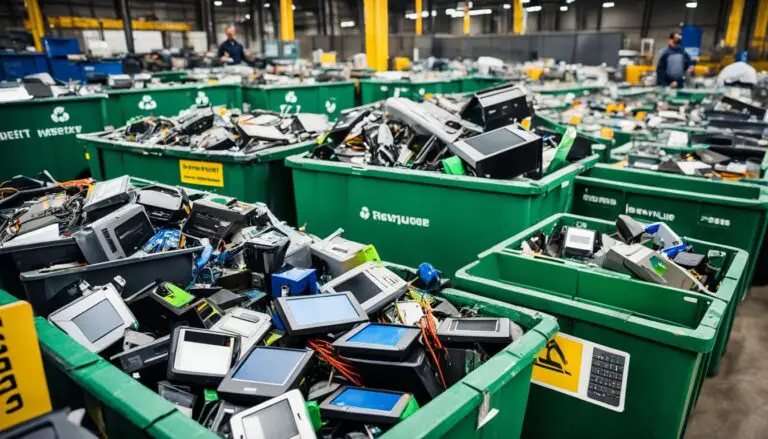As technology continues to advance at a rapid pace, the disposal of electronic waste, also known as e-waste, has become a pressing environmental concern. Recycling electronics responsibly is crucial in order to protect the environment and effectively manage e-waste. The improper disposal of electronic waste can have harmful effects on ecosystems and human health.
In this article, I will explore the various aspects of responsible electronics recycling and provide essential tips for proper e-waste management. By understanding the best practices for recycling electronics, we can ensure that they are handled responsibly and sustainably.
Key Takeaways:
- Responsible electronics recycling is essential for protecting the environment and minimizing the health risks associated with improper e-waste disposal.
- Proper e-waste management involves finding reputable recycling facilities, securely erasing personal data, and separating electronic components for recycling.
- Government initiatives and technological advancements play a crucial role in promoting responsible electronics recycling and sustainable resource management.
- Consumers can contribute to responsible electronics recycling by making sustainable choices and supporting brands that follow extended producer responsibility.
- Together, we can create a more sustainable future by minimizing our impact on the planet through responsible electronics recycling.
The Importance of Responsible Electronics Recycling
Electronic waste, also known as e-waste, contains hazardous materials such as lead, mercury, cadmium, and brominated flame retardants. Improper disposal of e-waste can result in the release of these toxins into the environment, causing pollution of air, water, and soil. This can have detrimental effects on human health and ecosystems. Responsible electronics recycling ensures that these hazardous materials are safely extracted and disposed of, preventing their harmful impact. It also allows for the recovery of valuable materials from electronic devices, reducing the need for virgin resources and promoting sustainable resource management.
When electronic waste is dumped in landfills or incinerated, harmful substances can leach into the surrounding environment. For example, lead, commonly found in cathode ray tubes and solder, can contaminate soil and groundwater. Mercury, often present in flat-screen monitors and fluorescent lamps, can vaporize and enter the atmosphere, contributing to air pollution. Cadmium, found in rechargeable batteries, can accumulate in plants and animals, entering the food chain and posing risks to human health.
Responsible electronics recycling mitigates these environmental risks. By ensuring that e-waste is handled properly, hazardous materials can be safely removed and disposed of through appropriate treatment methods. This prevents the release of toxins into the environment, protecting ecosystems and reducing the overall environmental impact of e-waste.
Furthermore, responsible electronics recycling promotes efficient resource management. Electronic devices contain valuable materials such as copper, gold, silver, and palladium. By recycling these devices, these materials can be recovered and reused in the production of new electronics, reducing the need for extraction of virgin resources. This conserves natural resources, minimizes energy consumption, and helps create a more sustainable and circular economy.
Best Practices for Recycling Electronics Responsibly
When it comes to recycling electronics responsibly, there are several best practices that can help ensure the process is carried out in an environmentally friendly and sustainable manner. By following these guidelines, you can play a part in reducing electronic waste and promoting eco-friendly recycling practices.
Find a Reputable Recycling Facility
One of the first steps in recycling electronics responsibly is to find a reputable e-waste recycling facility or program. Look for facilities that adhere to proper environmental and safety standards. These facilities employ eco-friendly recycling methods that minimize harm to the environment and maximize resource recovery. By choosing a reputable facility, you can have peace of mind knowing that your electronic devices will be recycled responsibly.
Securely Erase Personal Data
Prior to recycling your electronic devices, it is crucial to securely erase any personal data they may contain to protect your privacy. This involves deleting all personal files, resetting the device to factory settings, and, if necessary, physically destroying the storage media to ensure data cannot be recovered. By taking these steps, you can ensure that your personal information remains confidential and doesn’t end up in the wrong hands.
Separate Components and Materials
Another important practice in responsible electronics recycling is to separate the different components and materials for recycling. Different parts of electronic devices require specific recycling methods due to the variety of materials used. For instance, batteries need to be recycled separately, as they contain hazardous substances that can be harmful to the environment if not properly handled. By separating components and materials, you help facilitate the recycling process and improve its overall efficiency.
| Benefits of Responsible Electronics Recycling: |
|---|
| 1. Reduces landfill waste |
| 2. Conserves valuable resources |
| 3. Prevents pollution caused by hazardous materials |
| 4. Promotes sustainable resource management |
By adhering to these best practices for recycling electronics responsibly, you can contribute to the reduction of electronic waste and its negative environmental impact. Taking the extra step to find a reputable recycling facility, securely erase personal data, and separate components and materials not only protects the environment but also ensures that valuable resources are conserved for future use.
Remember, responsible electronics recycling is an essential part of sustainable resource management and plays a crucial role in protecting our environment for future generations.
Government Initiatives for Responsible Electronics Recycling
Governments around the world have implemented various initiatives to promote responsible electronics recycling. These programs aim to provide convenient and accessible options for consumers to recycle their electronic devices.
Some government programs offer free electronics recycling services, allowing individuals and businesses to dispose of their e-waste properly without incurring additional costs. This not only encourages more people to participate in recycling but also removes financial barriers that may deter individuals from responsibly disposing of their electronic devices.
Additionally, governments also provide subsidies or incentives to incentivize the recycling of electronics. These financial incentives can range from tax credits to reimbursements for recycling costs, making it more financially viable for businesses and individuals to recycle their electronic waste.
These government initiatives play a crucial role in raising awareness about e-waste management and promoting sustainable recycling practices. By supporting and implementing these programs, governments demonstrate their commitment to protecting the environment and encouraging responsible e-waste disposal.
“Government programs for e-waste recycling provide convenient and accessible options for consumers to recycle their electronic devices, such as free electronics recycling services and subsidies to incentivize recycling.”
The Impact of Government Initiatives
Government programs for e-waste recycling have had a significant impact on increasing recycling rates and reducing the improper disposal of electronic waste. By offering free recycling services, governments have made it more convenient for individuals to responsibly dispose of their old electronic devices, preventing them from ending up in landfills or being incinerated.
The subsidies and incentives provided by governments have also encouraged businesses and individuals to participate in electronics recycling. By reducing the financial burden associated with recycling, these programs have made it more economically viable for organizations to invest in proper e-waste management.
Overall, government initiatives have not only raised awareness about the importance of responsible electronics recycling, but they have also created a culture of sustainability and environmental responsibility. Through these programs, governments are actively working towards reducing the environmental impact of electronic waste and promoting a more sustainable future.
The Role of Technology in Responsible Electronics Recycling
Technology has significantly advanced the field of responsible electronics recycling, enabling more efficient and sustainable treatment of e-waste. Through innovations in recycling methods and technologies, we have made significant progress in reducing the environmental impact of electronic waste while maximizing resource recovery.
Advancements in the separation and recovery of valuable materials from electronic devices have revolutionized e-waste recycling. These technological advancements have not only increased recycling rates but also reduced the reliance on virgin resources. By extracting and reusing precious metals like gold, silver, and copper, we can minimize the need for destructive mining practices.
The development of specialized recycling processes for specific types of electronic waste has further improved recycling efficiency and effectiveness. For instance, innovative methods for recycling batteries and printed circuit boards have been implemented to ensure their proper treatment, preventing potential harm to human health and the environment.
One of the noteworthy e-waste treatment techniques is the use of advanced sorting technologies. These methods employ automated systems and artificial intelligence to identify and separate different components of electronic devices, making the recycling process more precise and efficient.
In addition, the implementation of robotic systems has facilitated the disassembly of complex electronic products, allowing for the retrieval of valuable components and materials that would otherwise go to waste. This not only enhances resource recovery but also reduces the environmental footprint of e-waste recycling.
Innovative Recycling Methods
With the constant evolution of technology, new and innovative recycling methods continue to emerge. These methods focus on extracting valuable materials from electronic waste, ensuring their proper disposal, and reducing the environmental impact of e-waste.
“The application of cutting-edge technologies in e-waste recycling has revolutionized the industry and paved the way towards a more sustainable future.”
One such method is hydrometallurgical recycling, which involves using chemical processes to dissolve metals from electronic waste. This technique allows for the recovery of valuable resources in a controlled manner, minimizing the release of hazardous substances into the environment.
Another innovative approach is pyrometallurgical recycling. This method uses high-temperature processes to extract metals from e-waste, thereby reducing the volume of waste while extracting valuable materials. Through this technique, we can recover and reuse metals with high melting points, such as aluminum and copper.
Technological Advancements in E-Waste Recycling
Technological advancements have also paved the way for improved monitoring and tracking of e-waste throughout the recycling process. With the help of blockchain technology, we can now trace the journey of electronic waste from collection to recycling, ensuring transparency and accountability.
Moreover, the use of advanced analytics and data management systems allows for better insights into the volume and composition of e-waste, enabling more informed decision-making in recycling operations. This data-driven approach facilitates the identification of potential bottlenecks and optimization of recycling processes.
The Future of Responsible Electronics Recycling
The continuous development of technology will likely bring about further advancements in responsible electronics recycling. From improved sorting technologies to more efficient recycling methods, these innovations will play a pivotal role in addressing the challenges posed by e-waste.
By integrating these technological advancements into our recycling systems, we can ensure the sustainable management of electronic waste, reduce the environmental impact of e-waste disposal, and promote a circular economy.
Responsible Consumer Choices for Electronics Recycling
Responsible electronics recycling starts with making conscious choices as consumers. When we opt for products that are designed with recyclability and sustainability in mind, we actively contribute to reducing e-waste and promoting responsible recycling practices.
One important consideration is choosing electronics that are easily repairable and upgradable. By investing in devices that can be fixed or upgraded, we extend their lifespan and reduce the need for constant replacement, ultimately reducing the overall environmental impact.
Another crucial aspect is selecting electronics that are made from environmentally friendly materials. By choosing products that use recycled materials or renewable resources, we support a more sustainable manufacturing process and help reduce the demand for virgin resources.
“Choosing eco-friendly electronics not only benefits the environment but also provides opportunities for innovation and advancement in sustainable design.”
Supporting brands and manufacturers that follow the principles of extended producer responsibility (EPR) is another essential way to promote responsible electronics recycling. EPR requires companies to take responsibility for the entire lifecycle of their products, including recycling and proper disposal. By supporting these brands, we encourage the adoption of sustainable practices throughout the industry.
To summarize, responsible consumer choices play a crucial role in driving the shift towards a more sustainable electronics industry. By selecting easily repairable, upgradable, and environmentally friendly products, and supporting brands that embrace extended producer responsibility, we can contribute to reducing e-waste and promoting responsible electronics recycling. Together, we can make a difference in creating a more sustainable future.
Conclusion
Responsible electronics recycling is crucial for protecting our environment and effectively managing e-waste. By following best practices and adopting sustainable resource management, we can make a positive impact and ensure a greener future.
Properly recycling electronics is essential in minimizing the environmental and health risks associated with improper e-waste disposal. Finding reputable recycling facilities to handle electronic devices responsibly and securely erasing personal data before disposal are key steps in responsible electronics recycling.
Government initiatives and technological advancements in e-waste recycling have also played a significant role in promoting sustainable resource management. With the support of government programs, recycling facilities can provide accessible and convenient options for consumers to recycle their electronics, reducing the burden on landfills and preventing pollution.
Ultimately, responsible electronics recycling starts with responsible consumer choices. By opting for products that are designed with recyclability, upgradability, and sustainability in mind, we can contribute to reducing e-waste and promoting a circular economy. Supporting brands that follow extended producer responsibility (EPR) principles further encourages responsible electronics recycling.
Together, let’s take responsibility for our electronic waste and make a difference in creating a more sustainable future.
FAQ
Why is responsible electronics recycling important?
Responsible electronics recycling is important because it helps protect the environment and effectively manages e-waste. Improper disposal of electronic waste can lead to harmful effects on ecosystems and human health.
What are the hazardous materials present in electronic waste?
Electronic waste, also known as e-waste, contains hazardous materials such as lead, mercury, cadmium, and brominated flame retardants.
What are the best practices for recycling electronics responsibly?
The best practices for recycling electronics responsibly include finding a reputable e-waste recycling facility or program, securely erasing personal data from electronic devices before recycling, and separating electronic components and materials for proper recycling.
What initiatives have governments implemented for responsible electronics recycling?
Governments around the world have implemented various initiatives such as free electronics recycling services and subsidies to encourage responsible electronics recycling.
How has technology contributed to responsible electronics recycling?
Technology has played a significant role in advancing the field of responsible electronics recycling by enabling more efficient and sustainable treatment of e-waste. Innovations in recycling methods and technologies have increased recycling rates and reduced the reliance on virgin resources.
What can consumers do to promote responsible electronics recycling?
Consumers can promote responsible electronics recycling by choosing products that are easily repairable, upgradable, and made from environmentally friendly materials. Additionally, supporting brands and manufacturers that follow extended producer responsibility (EPR) principles can further encourage responsible recycling.



